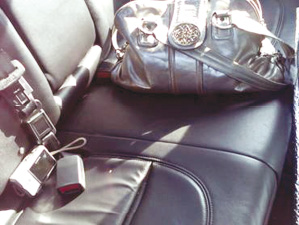
By Leslie Collins
Northeast News
November 30, 2011
Kansas Citians are continuing to entice criminals to break into vehicles.
From shopping bags to purses to laptops, residents are leaving their valuables in plain sight, and it’s eating away at Kansas City Police Department resources.
“People don’t understand that the resources we deploy to handle those types of crimes (car break-ins) are resources that are taken out of our neighborhoods,” Central Patrol’s Master Patrol Officer James Schriever told Northeast News. “If we can reduce those types of crimes, then we can put those resources back into our neighborhoods to No. 1 address the violent crime issue and No. 2 to be more preventative and actually patrol neighborhoods instead of just being responsive.”
Items of value can range from golf clubs to purses to spare change, he said.
“We had a situation where an owner of a Mercedes Benz had to replace an approximately $500 window for 35 cents in change,” Schriever said.
That was the change he got back from his morning cup o’ joe and threw into the middle console.
“You’ve got to understand that 35 cents attracts a certain demographic of criminal,” Schriever explained.
Those ready to break into a vehicle for spare change are addicts coming one step closer to satisfying their chemical dependency. If it’s a cheap bottle of liquor they’re after, 35 cents is one-third of the way to purchasing it, he said.
The professional criminal won’t bother with petty items like spare change, Schriever said. That criminal will look for both items of value and “indicators” of value. Indicators can range from a GPS cradle to a cell phone or iPod charger to bulky blankets and jackets.
“Criminals know what’s under the jackets, what’s under the blanket,” he said. “It serves no purpose to cover Christmas items with a blanket or jacket. We’ve got criminals who tell us that’s an indicator.”
Criminals believe people will take the “least amount of energy” to secure their items, he said. So, a cell phone charger could mean there’s a cell phone inside the console or a GPS cradle could mean the GPS is in the glove box. Criminals also look for suction cup marks on the window.
Even bills and mail are enticing items, he said. By looking through your mail, a criminal can learn your address and other personal information and use that to not only break into your vehicle, but into your home. Most people leave their garage door openers in their vehicle, giving the criminal direct access to the residence, Schriever said.
Residents should remove both indicators and items of value from plain sight, he stressed.
Recently, Schriever peered into 63 parked vehicles looking for items of value and discovered that 60 of the vehicles had items of value in plain sight. Metrowide, there are 20,000 incidents of theft from automobiles every year and that’s using a conservative number, he said. In the Central Patrol Zone, more than 4,200 incidents have been reported this year.
Vehicle break-ins aren’t just a Kansas City issue, Schriever said.
“A lot of people get the stigma that it just occurs in Kansas City, but that’s absolutely not true,” he said. “This is a crime that is growing nationwide from major metropolitan cities to small rural counties. It’s affecting them. It doesn’t matter whether you’re in Kansas City, a suburb or a neighborhood, if you leave a $1,200 laptop inside your vehicle, it’s going to get broken in to.
“The criminals call it ‘feeding the bears.’ If you don’t want the bear to come back, don’t feed him.”
Schriever asked for community support in reducing the number of vehicle break-ins.
“The only way we’re going to make an impact on the reduction of these numbers is from the community because statistics show that almost 90 percent of stealings (from vehicles) can be reduced or can be prevented,” he said. “So, it’s got to be a conscious effort and an aggressive effort from the community to make an impact.”
















